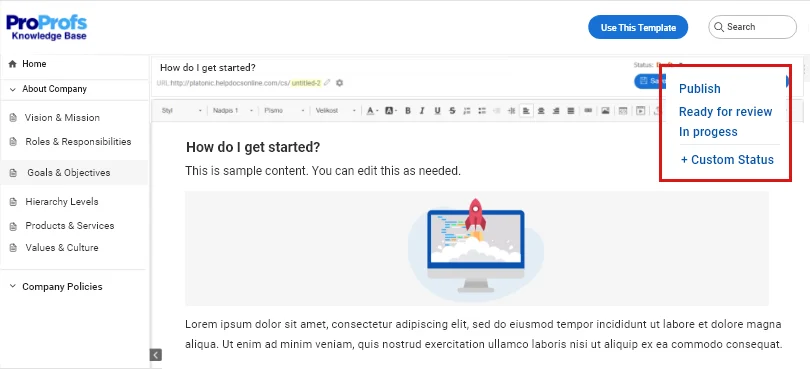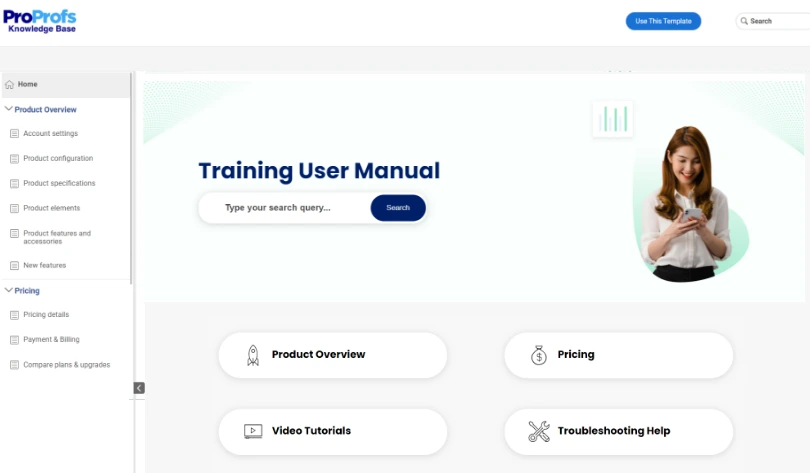
Declining employee productivity and increasing turnover rates are two of the major concerns of businesses today.
Creating a training manual is a practical solution that can give you a respite from several workplace-related problems. It helps create a culture of continuous learning by making training resources and business information available for employees right at their fingertips.
This sheer convenience of getting all that they need in a few clicks is a huge help for employees every time they are on client calls, working on a project, or confused about a decision.
The right job training increases efficiency and productivity at work. When this happens, employees turn better at what they do – resulting in quality, on-time deliverables that positively impact your firm’s growth. In this blog, we have provided expert tips, steps, and practical advice to help you create a training manual that engages and inspires your employees. Let’s dive in!
What Is a Training Manual?
A training manual acts as a one-stop portal where employees can get all the assistance they need to perform tasks and excel in their roles. It is a valuable resource that guides employees at every step of the way, helping them overcome challenges, solve problems and upskill themselves.
With well-structured articles and how-to videos, the manual makes it easy for employees to understand your work processes, culture, and policies. Moreover, discovering information is a piece of cake with the manual’s robust search system that shows relevant responses matching employees’ queries.
Types of Training Manuals
Depending on the type of training and the content involved, there are various types of manuals to choose from. Let’s take a closer look at the different types of training manuals that will help you determine the best fit.
Employee Handbook
An employee handbook is an important document for onboarding new hires. It is a comprehensive document explaining your company’s policies, procedures, products, clients, projects, etc.
It serves as a guidebook for new employees and provides them with crucial information about their rights and responsibilities in the workplace, so they can get up to speed faster.
Project Documentation
Project documentation is where your employees will get complete information about critical company projects – key details such as project proposals, project status reports, business cases, project plans, and a lot more. Easy access to project details ensures your teams are on the same page and stay on top of all developments taking place across projects.
Process documentation
Process documentation consists of step-by-step procedures on how to perform tasks or carry out work processes with maximum efficiency and minimum errors. This document gives a detailed step-by-step explanation of your business processes, demonstrating them through relevant images and videos for easier understanding.
Using tools like flowcharts and diagrams, the documentation ensures employees gain complete clarity of how to successfully execute a process or task.
Internal Wiki
An internal wiki is a collaborative web-based platform where teams come together to share knowledge, ideas, and expertise. It provides an effective way to centralize company knowledge, streamline communication, and facilitate information flow across departments. Employees can access the learning resources anytime they need which improves their productivity and decision-making abilities.
Why Are Training Manuals Important?
Research indicates that for 92% of employees, well-planned employee training programs positively affect their level of engagement.
Training manuals not only help employees understand their job duties and responsibilities but also help them acquire new skills and knowledge necessary to keep up with the ever-changing business landscape.
With a training manual in place, you can cultivate a continuous learning culture to help employees stay relevant and be their productive best at work. A carefully-crafted training manual also ensures that employees across departments receive consistent and standardized training.
Notable Benefits of Training Manuals
Training manuals can be a valuable tool for your organization. By investing in comprehensive training manuals, you can rapidly improve job performance, employee engagement, and overall business success.
Let’s look at the benefits you can reap by building training manuals:
Boosts Employee Productivity
Employee training is a sure-shot way to increase workforce productivity. When employees have clear guidelines and instructions for performing their duties, they are better equipped to complete tasks efficiently and accurately.
Training manuals act as reference points that employees can use to hone their skills, brush up their knowledge on a subject, and gain the required expertise in their area of interest.
It is an effective way to make employees feel more supported, reduce errors, boost morale, and increase their confidence. Employees who feel confident about their role are more likely to take on new challenges and work with renewed enthusiasm.
Aids Employee Onboarding
Onboarding is an excellent way to set the right expectations right from the first day of a new employee. However, onboarding can take weeks or even months when executed the traditional way and make employees feel overwhelmed in their initial days.
With full-fledged training manual software, new employees will have a 24×7 learning resource at their disposal. They can self-learn your company mission, vision, and policies and get a peek into your company culture.
With clear instructions manual to follow, new employees feel confident about their new workplace and start contributing positively to their new job.
Read More: Employee Onboarding: How to Use Your Knowledge Base Effectively
Cultivate a Culture of Continuous Learning
Every employee today wants to be a part of a company that values their learning and development. Creating a training manual will put your brand in a favorable light by making a positive impact on the career course of employees.
Employees will realize how much your business values their professional growth and will be ready to go above and beyond in the work they do. Investment in the continued learning of employees will eventually turn employees into brand ambassadors and will prove immensely beneficial in the long run.
Reduces Training Costs
Training manuals help in reducing training expenses to a large extent. Physical training sessions often burn a hole in a company’s pocket, given that they are organized multiple times a year. Moreover, they are also draining and time-consuming for employees.
Creating a training manual can help employees self-train and learn at their own pace. You just need to make a one-time investment in an appropriate tool and reap the benefits all year long. It’s far cheaper, efficient, and time-saving.
Simple Steps to Create a Training Manual for Your Employees
Creating a comprehensive training manual can be daunting, but it can be a lot easier if you follow a well-defined process. Here are some essential steps to create a training manual that is both effective and engaging.
Define Your Scope and Objectives
Before you start creating a training manual, it’s essential to determine what you want to accomplish. It involves defining your scope and objectives. It will help you focus your efforts and create a more effective manual that is adept at addressing employees’ needs and concerns.
Defining the scope helps you identify the topics you should be covering and issues you should be addressing in your training manual. Besides, it will also help you determine the goals you intend to achieve once your training manual is up and running.
The process of defining the scope and goals of your manual start by asking yourself a few questions:
- Who is your audience and what is the level of their knowledge?
- What problems are you trying to solve?
- How will employees benefit from it?
- How comprehensive should your manual be?
Answering these questions will keep you laser-focused on the task and help you give your best in the process.
Create a Content Outline
Once you’ve defined the scope and objectives, the next step is to create a content outline. A content outline will help you organize your thoughts and create a logical flow for your manual.
Identify the key topics you want to cover and any subtopics or details that need to be included in your manual.
A well-organized outline makes it easier to write the content and ensures the information is presented in an easily digestible format.
The outline should also include the order of topics to ensure content is not added randomly into the manual. It should also define the essential structural elements that should be included, such as a table of contents, a home page, and a thank you page.
The primary purpose of the content outline is to ensure your team faces minimum trouble while creating the manual.
With a set structure, all they will have to do is focus on creating compelling content. Moreover, a meticulously-structured manual is easy to navigate for employees, which makes information discovery a whole lot easier.
Establish a Powerful Team
Creating a training manual requires the collective effort of multiple employees who work together under a single roof to produce flawless content. While collaborative authoring expedites the process, it also ensures your manual has the most unique insights and relevant information for employees to consume.
Before collaboration starts, you need to assemble a strong team comprising employees who have in-depth knowledge of subjects pertaining to your work policies, culture, industry, etc.
Once you identify key employees to be included in your team, assign them roles like contributors, editors, and administrators. These roles come with their own set of permissions and responsibilities to prevent team members from stepping into each other’s shoes.
Besides, most training manual tools also offer features like internal comments that allow team members to collaborate internally on articles, discuss changes, and stay on top of all developments.
Watch this quick video to understand how your team can collaborate to create a training manual.
Start Developing Training content
With the content outline and team in place, you can start to write your training manual.
The process involves writing clear content that explains specific functions in an easy-to-understand format.
You can also include images, gifs, and videos, wherever possible, to explain complex concepts. Adding visuals will enhance the overall appeal of the manual, imparting employees an interactive learning experience.
When creating content, consider these simple tips for maximum results:
- Use simple and straightforward language
- Write short sentences and paragraphs
- Avoid large blocks of text
- Provide enough information on a specific topic
- Use bulleted points to make content scanning easier
These simple tips will prove instrumental in building content that’s easy to consume for your employees.
Review & Publish Your Manual
Once your training manual is complete, thoroughly review it for errors, inconsistencies, and knowledge gaps.
When humans work on something, mistakes are bound to happen.
The question is – how to correct these mistakes and ensure the final output is completely error-free?
A systematic review and approval process is all you need for every article in your training manual to be vetted before going live.
Most online training manual tools are equipped with a review workflow system that allows your team to define the status of each article and track it from creation to publication.
For example, depending on an article’s stage, you can assign it an appropriate status such as – Draft, In Progress, Ready for Review, and Published. You can also set a custom status if the article stage doesn’t match any of these predefined statuses.
Looking at the status of each article, team members will get an instant hint of what’s reviewed, what’s good to go, and what’s pending at the writer’s or editor’s end. This maintains transparency in the process and keeps everyone on the same page.

Capture Feedback From Employees
Next, you need to capture feedback from employees, which will help you understand if they are really finding your training manual useful.
Giving employees the option to share feedback on every article makes them feel cared and they will be more than happy to support your endeavor of improving the manual’s quality. Taking feedback also makes them feel valued and an integral part of your organization.
Now, to collect feedback, you can add forms at the bottom of every article. These forms come with a single question, like – “Was this information helpful?”. This question comes with Yes/No as the answer options.
On clicking “No”, a comment box appears where employees can explain the issue.
This feedback mechanism will introduce you to both aspects of your manual you didn’t know existed. You will be able to identify improvement areas and make informed decisions to enhance your manual’s quality.
Here’s a quick video on how you add forms and surveys to your training manual.
Monitor & Improve Performance
Using a dated manual with irrelevant information can increase the chances of mistakes, affecting employees’ performance and productivity. These mistakes can cost you dearly in the form of delayed deliverables and inadequate work quality.
Moreover, regular updates will keep the training resources in alignment with your latest policies and regulations, which is extremely important to train your employees the right way.
Before you go on to add or delete articles, you should first measure how your manual is performing and what really needs to be improved.
- Are there broken links that need fixing?
- Which articles have received the most downvotes?
- Which articles are popular among employees?
- Which keywords fail to yield the right results?
The answers to these questions can be found in reports – a feature most training manual tools offer. A built-in reporting system gives useful insights into your manual’s performance, so you can make smart decisions on time.
Watch this quick video to explore the potential of reports and learn how to analyze them.
How to Make Your Training Manuals Interactive?
By making your training manuals interactive, you can break up the monotony of reading and make the entire learning process more enjoyable.
Let’s explore some simple tips and tricks to achieve a highly interactive training manual.
- Use appealing visuals – Use images, videos, infographics, and charts to demonstrate concepts and processes. Visual imagery enhances the overall not only enhances the overall look and feel of the manual but also provides an immersive learning experience to employees.
- Add quizzes and assessments – Create quizzes and assessments throughout your training manual to make it fun and interesting. It can help employees track learning progress and assess how much they have grasped.
- Align the manual with your branding – Aligning the training manual with your branding will help create a sense of familiarity and reinforce the values you stand for.
- Incorporate Gamification – Gamification involves incorporating game-like elements into your training manual, such as points, badges and leaderboards. It can make the training manual and the entire learning experience more engaging and fun for employees.
- Add an online forum – An online forum is a great way to foster collaboration and spark discussions among employees. It can help them ask questions, share knowledge and learn from each other.
Training Manual Templates & Examples
Training manual templates have a pre-designed structure comprising a home page, topic-specific headers, title pages, and a table of contents. They provide a starting point for creating consistent and high-quality training manuals.
Using templates to create a training manual will lessen your load, and you can pretty much jump right into writing training manual content. You can customize the entire manual and add or remove topics or subtopics based on your outline.
Here is an example of a training manual template you can use as you start working on the content:

Build a Culture of Lifelong Learning
Creating a training manual can be a game-changer for your company’s success.
With a training manual in place, you can significantly improve employee productivity and cultivate a knowledge-sharing culture in your workplace.
Moreover, it can save you a tremendous amount of money. You just have to create it once and your employees can use it for as long and as many times as they want.
With dedicated training resources at their disposal, learning is more convenient for employees. Knowledge sharing also gets streamlined and employees get better at decision-making, innovation, and creativity.
The process of creating a training manual can be a bit challenging, and that’s why you need a tool like ProProfs.
Employing ProProfs Knowledge Base can help you launch a stunning manual that’s well-structured, interactive, and mobile-friendly.
Do you want a free Knowledge Base?
We have the #1 Online Knowledge Base Software for instant self-help







